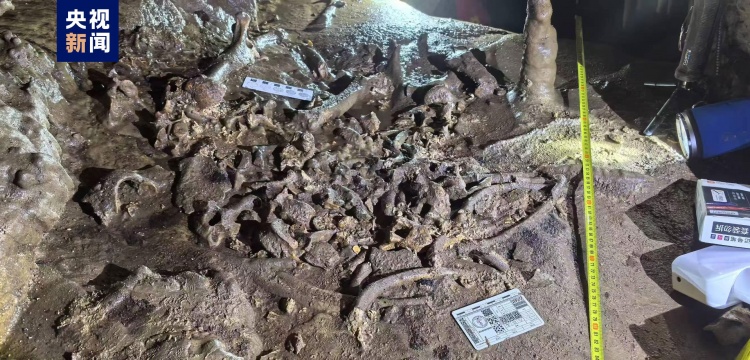A well-preserved giant panda fossil, dating back at least 10,000 years, has been discovered in a cave in Northwest China's Shaanxi province, the provincial department of natural resources said on Wednesday. The skull fossil was more than 90 percent complete, while the other skeletal fossils were about 70 percent complete. Experts have tentatively determined that the fossils date from 200,000 to 10,000 years ago. ,.
A remarkably well-preserved fossilized giant panda dating back over 10,000 years has been discovered in a limestone cave in Shaanxi Province, northwest China.
Located in Chenggu County, Hanzhong City, the cave yielded the panda remains on a limestone platform 180 meters deep.
Over 90 percent of the skull and 70 percent of the overall skeleton remain intact. Researchers said such a find is exceedingly rare. Initial analysis of the skull, teeth and sagittal crest suggests the fossil is of an adult female giant panda.
By examining the fossil's condition and mineralization, experts determined its age to be between 200,000 and 10,000 years old, placing it in the middle to late Pleistocene epoch. This discovery is invaluable for understanding the evolutionary history and survival of giant pandas in the Qinling and Daba Mountains.
"Previous giant panda fossils were typically fragmented, consisting of isolated teeth or bones," said Hu Songmei, a member of the Shaanxi Provincial Paleontological Fossil Expert Committee, who conducted a preliminary identification of the bones at the site. "This nearly complete skeleton, including the skull, metatarsal bones and vertebrae, is unprecedented in Shaanxi and likely in the entire country."
A total of 33 fossil specimens have been collected, and the Shaanxi Provincial Department of Natural Resources will now lead efforts to restore the fossils and conduct further scientific research.








 Stratonikeia Antik Kenti'ndeki Roma Hamamında Restorasyon Tamamlandı
Stratonikeia Antik Kenti'ndeki Roma Hamamında Restorasyon Tamamlandı  Ağrı Dağı'ndaki Takke Buzulunda Erime Devam Ediyor
Ağrı Dağı'ndaki Takke Buzulunda Erime Devam Ediyor  Kurtuba Cami-Katedrali'ndeki Yangın Söndürüldü
Kurtuba Cami-Katedrali'ndeki Yangın Söndürüldü  Bakırköy'de iki katlı ahşap tarihi bina kısmen çöktü
Bakırköy'de iki katlı ahşap tarihi bina kısmen çöktü 




